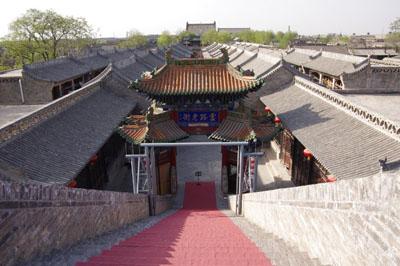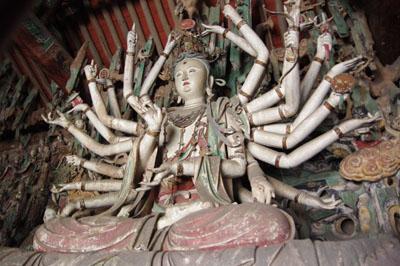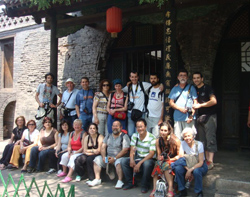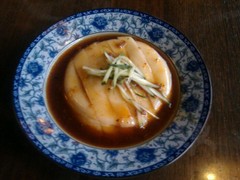
Bullet Train Tour to Pingyao,
A UNESCO Old Town of China
2-day
express tour to Pingyao, Shanxi
heritage site on bullet trains from Beijing
HIGHLIGHTS:
* Discover the ancient town of Pingyao, one of the only
cities in China to maintain its ancient city walls and
streets. Being here will transport you back in time to
the China of yesteryear. The city is something of a
living museum
* Tour the exquisite ancient Buddhist temples of Pingyao,
which are haunting and captivating in their beauty, as
well as being a gateway to the ancient traditions of
China
* Your hotel will be in the style of a traditional
courtyard, giving you a much more intimate and memorable
experience than the normal hotel
Detailed Itinerary:
Day 1: Beijing-Pingyao (L, D)
You will take the morning bullet train D2001 (07:58 am)
from Beijingxi to Pingyao Old Town. Upon
arrival at the station at 12:13 noon, you will be met by your
English-speaking guide and driver. We'll immediately get
started on your tour. For much of todays touring, we
will be walking within the ancient town of Pingyao,
which is built in the style of traditional Chinese urban
planning, which includes 4 main streets, 8 narrow roads,
and 72 smaller lanes, all of which for a neat and
logical grid.
The three-story Market Tower is the center and joint
 point of the city streets. The buildings such as Ancient
City Government seat, Town God's Temple, Confucius
Temple, Military God Temple, Wealth God Temple and Lucky
Fortune Temple are arranged symmetrically. With its main
streets forming a "干"shape, there are altogether four
main streets, eight branch streets and 72 lanes in the
city area. Having stood a long time weather-wearing, all
these buildings show no sign of dilapidation. In front
of the gates of some magnificent buildings and grand
shops, deep ruts on the ground are still there to be
seen, reminding visitors of its ancient busy traffic and
commercial situation. The streets in this ancient town
are broad and very well arranged. Dotted with memorial
archways and decorated gateways, stretching one after
another and high and low, the old houses and courtyards
flanking the streets and lanes remind visitors of the
long past and their ancestral places. Walking along the
ancient streets, you seem to have landed in a world
beyond the present one. 18.5 meters in height, and
situated in the town center, the Market Tower is the
highest building within the main street from the south
to the north running through it. it is said the
marketing was going on around the Tower all day long,
thus it was named the Market Tower. Belonging now to the
historical sites protected by the provincial government,
it was renovated in 1688 during the Emperor Kangxi
Period of Qing Dynasty, but people still don't know when
it was first built. point of the city streets. The buildings such as Ancient
City Government seat, Town God's Temple, Confucius
Temple, Military God Temple, Wealth God Temple and Lucky
Fortune Temple are arranged symmetrically. With its main
streets forming a "干"shape, there are altogether four
main streets, eight branch streets and 72 lanes in the
city area. Having stood a long time weather-wearing, all
these buildings show no sign of dilapidation. In front
of the gates of some magnificent buildings and grand
shops, deep ruts on the ground are still there to be
seen, reminding visitors of its ancient busy traffic and
commercial situation. The streets in this ancient town
are broad and very well arranged. Dotted with memorial
archways and decorated gateways, stretching one after
another and high and low, the old houses and courtyards
flanking the streets and lanes remind visitors of the
long past and their ancestral places. Walking along the
ancient streets, you seem to have landed in a world
beyond the present one. 18.5 meters in height, and
situated in the town center, the Market Tower is the
highest building within the main street from the south
to the north running through it. it is said the
marketing was going on around the Tower all day long,
thus it was named the Market Tower. Belonging now to the
historical sites protected by the provincial government,
it was renovated in 1688 during the Emperor Kangxi
Period of Qing Dynasty, but people still don't know when
it was first built.
Well come across the Ri Sheng Chang bank, which was the
scene of Chinas modern banking and commercial business.
As early as in 1824, Ri Sheng Chang bank had begun its
business. Within a few years of its founding, its branch
banks were rapidly distributed to Jiangsu, Shandong,
Henan and Liaoning Provinces. Branch banks were also set
up in such big cities as Beijing. Today, people can
still trace its great prosperity of the bank groups
nicknamed as the "Asian Wall Street" from the remaining
bank and shop buildings along the West Main Street in
ancient Pingyao City.
Youll have the chance to walk along Pingyaos ancient
city wall, which is one of the only cities (along with
Xian) in China to have its city wall intact. Built with
rammed earth inside and brick and stone outside, the
ancient city walls measure 10 meters high and 6162.7
meters long with 3-5 meters wide tops. Except the
southern wall, which zigzags a bit according to the land
contour, the other three walls all go straight, making
the city area a square one. One city gate was built each
to the southern to northern walls and two city gates
were built each to the western and eastern walls. All
six city gates have gate towers and inside gates
attached to them. A watchtower was built on the wall top
every 50-100 meters away, totaling 72 watchtowers in all
along the four walls. From the wall you will have a
great view of the ancient city center.
For the evening, you will be staying in a traditional
Chinese courtyard hotel, a 4-star hotel located in the
heart of the ancient town.
Day 2: Pingyao-Beijing (B, L)
Following breakfast, your guide and driver will help you
with your luggage, and well get started on our
sightseeing for this day. Our first point of interest
today will be the Wang Family Courtyard. The Wang family
courtyard is an example in handing down and inheriting
the five thousand years' old Chinese civilization and a
peak-usurping masterpiece of Chinese civil residence
architecture of Qing Dynasty. It was built by the Wang
family in Jingsheng, the posterities of Taiyuan Wang
family, which in history had been one of the four large
families in Lingshi County. It was successively built in
the periods of Kangxi, Yongzheng, Qianlong and Jiaqing
in Qing Dynasty. The architecture has a magnificent
scale with five alleys, five forts, and five ancestral
temples. The three architectural complexes of Gaojiaya,
Red-gate Fort, and Chongningbao are all full closed
fortress architectures on the Yellow High Land (loess
high slope), which are closely connected with each other
through bridges. They appear grand and harmonious with
the surrounding environment and comply with the terrace
in both form and meaning. While in the inside, cave
houses and tile built houses get connected artfully and
excellently.
 The two main courtyards of the Gaojiaya architectural
complex are 3-year Siheyuan (quadrangles), which have
separate kitchen yards and home school yards with a
private tutor as well as a common classics-learning
academy, flower yard, long-term hired farm-laborer yard
and enclosed yard (servant yard), in addition to the
sacrificial ancestral hall at high place and the
embroidering buildings on both sides. The two main courtyards of the Gaojiaya architectural
complex are 3-year Siheyuan (quadrangles), which have
separate kitchen yards and home school yards with a
private tutor as well as a common classics-learning
academy, flower yard, long-term hired farm-laborer yard
and enclosed yard (servant yard), in addition to the
sacrificial ancestral hall at high place and the
embroidering buildings on both sides.
Our next destination will be the Shuanglin Temple. The
Shuanglin Temple is reputed to be the ancient painted
sculptures museum. The temple houses more than 2,000
colorful sculptures reflecting the exquisite skills of
the artisans of the Song, Yuan, Ming and Qing Dynasties.
The Shuanglin Temple was included in the World Heritage
List by UNESCO as an important cultural site of Ping Yao
City in 1997. Having a history of over 1,400 years, the
Shuanglin Temple contains ten large and small halls, as
well as the sutra chanting hall and the monks living
quarters.
Following our visit to the Shuanglin Temple you will be
driven to the Pingyaogucheng Station, where you will
take the express train back to Beijing, or wherever else
your next destination may be. Do keep in mind that Xian,
ancient Chinese capital and home to the Terracotta
Warriors, is very close by (D2509----1533/1821).
|



 |

